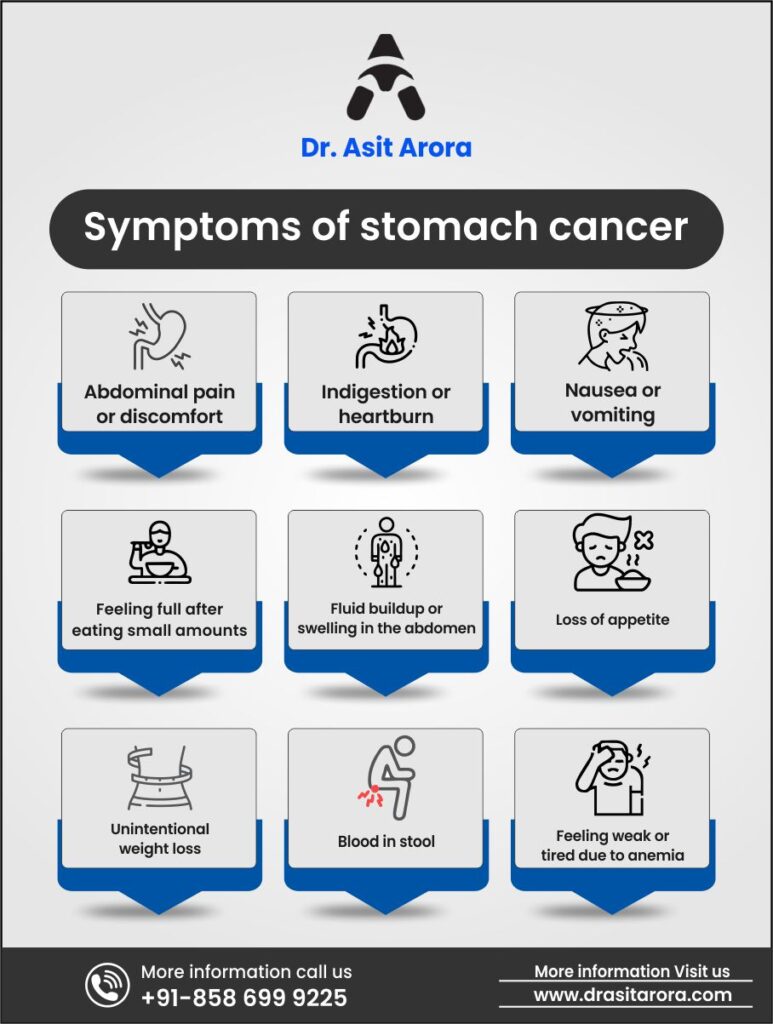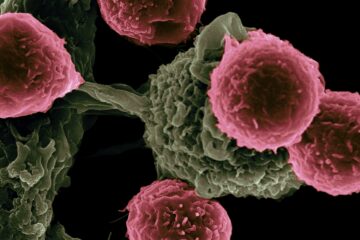Overview
Stomach or gastric cancer is a severe condition that develops in the stomach lining. It is one of the most common cancers worldwide. Early detection of stomach cancer is essential, as it can increase the chances of successful treatment and better outcomes. In this article, we’ll discuss the symptoms of stomach cancer and how it can be diagnosed.

Symptoms of stomach cancer
Stomach cancer can be challenging to detect in the early stages because symptoms may not appear until the cancer has advanced. However, some signs and symptoms can indicate the presence of stomach cancer. Here are some common symptoms of stomach cancer:
- Abdominal pain or discomfort
- Indigestion or heartburn
- Nausea or vomiting
- Feeling full after eating small amounts
- Fluid buildup or swelling in the abdomen
- Loss of appetite
- Unintentional weight loss
- Black coloured stool or Malena
- Feeling weak or tired due to anemia (less red blood cells)
Some of these symptoms may also be caused by conditions other than stomach cancer, such as an ulcer or a viral fever. If you experience any of these symptoms, especially if they persist for over a few weeks, it is crucial to see a doctor for further evaluation. Early detection and treatment of stomach cancer can improve your chances of a successful outcome.
Diagnosis of stomach cancer
Here are some ways to detect stomach cancer early:
Physical examination
A physical examination can also help detect stomach cancer early. During a physical exam, a healthcare provider may feel for any lumps or abnormalities in the stomach area and check for any signs of anemia, a symptom of stomach cancer. A physical exam can help identify potential signs of stomach cancer and may lead to further diagnostic testing.
Endoscopy and Biopsy
A biopsy for stomach cancer involves taking a small sample of tissue from the stomach lining to check for the presence of cancer cells. This procedure is usually done during an endoscopy. A thin tube with a camera and a small cutting tool is inserted through the mouth and down the throat into the stomach.
During the biopsy, the doctor will use the cutting tool to take a small tissue sample from the stomach lining. The sample is then sent to a laboratory for analysis by a pathologist, who will examine it under a microscope for any signs of cancer cells. It can also help doctors determine the best course of treatment for the patient.
Blood tests
Blood tests alone cannot diagnose stomach cancer. However, they can be used with other diagnostic tools to help detect and monitor the disease.
A complete blood count (CBC) is a blood test that measures the levels of different types of blood cells, including red blood cells, white blood cells, and platelets. Abnormal levels may indicate the presence of stomach cancer. However, CBC results can also be affected by other factors, such as infections or other medical conditions.
Tumor markers are substances produced by cancer cells or the body in response to cancer. The tumor marker that is most commonly used for stomach cancer is carcinoembryonic antigen CEA. Elevated levels of these markers in the blood may indicate the presence of stomach cancer. However, they can also be elevated in other conditions or even in healthy individuals.
Imaging tests
Imaging tests are commonly used to diagnose and monitor stomach cancer. One of the most common imaging tests is a plain abdomen x-ray, which can help detect abnormalities, such as tumors or blockages in the stomach or other organs.
Computed tomography (CT) scans are frequently used to diagnose stomach cancer. A CT scan uses X-rays and computer technology to create detailed images of the inside of the body. It can help identify the size and location of a tumor, as well as any nearby lymph nodes that may be affected.
Magnetic resonance imaging (MRI) is another imaging test that can be used to diagnose and monitor stomach cancer. An MRI uses powerful magnets and radio waves to create detailed images of the inside of the body. It can be beneficial for detecting tumors in soft tissues, such as the stomach lining.
Positron emission tomography (PET) scans are sometimes used to diagnose and stage stomach cancer. During a PET scan, a small amount of radioactive material is injected into the body. A special camera creates images of the radioactive material as it moves through the body. This can help identify areas of cancerous activity in the body.
Endoscopic ultrasound (EUS) is a procedure that combines endoscopy with ultrasound technology to create images of the stomach and surrounding areas. A small ultrasound probe is attached to the end of an endoscope and inserted through the mouth and throat into the stomach. EUS can help identify a tumor’s depth and any nearby lymph nodes that may be affected.
Screening Tests
Regular screening tests include endoscopy, which involves using a thin, flexible tube with a camera to examine the inside of the stomach.
Though done routinely in countries like Japan and Korea, it is not recommended for general cancer screening in India.
Only high risk patients or who have symptoms are offered this.
Screening for stomach cancer in average-risk people
In some countries, routine screening tests for stomach cancer are not recommended for people with average risk. This is mainly because the condition is uncommon in these countries, reducing the likelihood that the advantages of screening would outweigh any potential risks (including requiring additional procedures or tests, even in some individuals who might not develop stomach cancer).
As stomach cancer is not routinely screened in these countries, most patients are not diagnosed unless they exhibit certain symptoms and signs that require medical tests.
Mass population screening has helped detect many stomach cancers at an early, perhaps more treatable stage in some Asian countries where stomach cancer is substantially more prevalent. It’s unclear whether this has resulted in fewer deaths from stomach cancer.
Screening for stomach cancer in high-risk people
The advantages of screening may outweigh the risks in some individuals at higher risk for stomach cancer due to certain risk factors (For instance, certain stomach disorders may mark the onset of cancer or genetic diseases like familial adenomatous polyposis [FAP] or Lynch syndrome). For example, these people may benefit from regular upper endoscopy.
If you have risk factors for stomach cancer, consult a physician about the benefits and disadvantages of stomach cancer screening.
Why choose Dr. Asit Arora?
When it comes to stomach cancer, Dr. Asit Arora is a top choice for patients seeking expert care. He currently serves as the Director and head of the GI & HPB Oncology Division at Max Super Speciality Hospital Saket, and Max Smart. Dr. Arora is widely recognised as one of the best doctors for stomach cancer surgery in Delhi and across India.
His expertise includes HPB cancer surgery, advanced laparoscopic surgery, and gastrointestinal oncosurgery. In recognition of his outstanding contributions to the field of cancer care, he was awarded the prestigious title of Oncosurgeon of the Year at the 2022 ET Healthcare Awards.
Dr. Arora is committed to providing the best possible care to his patients, using the latest techniques and technologies to ensure the best possible outcomes. His compassionate and patient-centered approach ensures that his patients feel supported and informed throughout their journey with cancer. Choosing Dr. Asit Arora means choosing expert, compassionate care for stomach cancer.





[…] […]